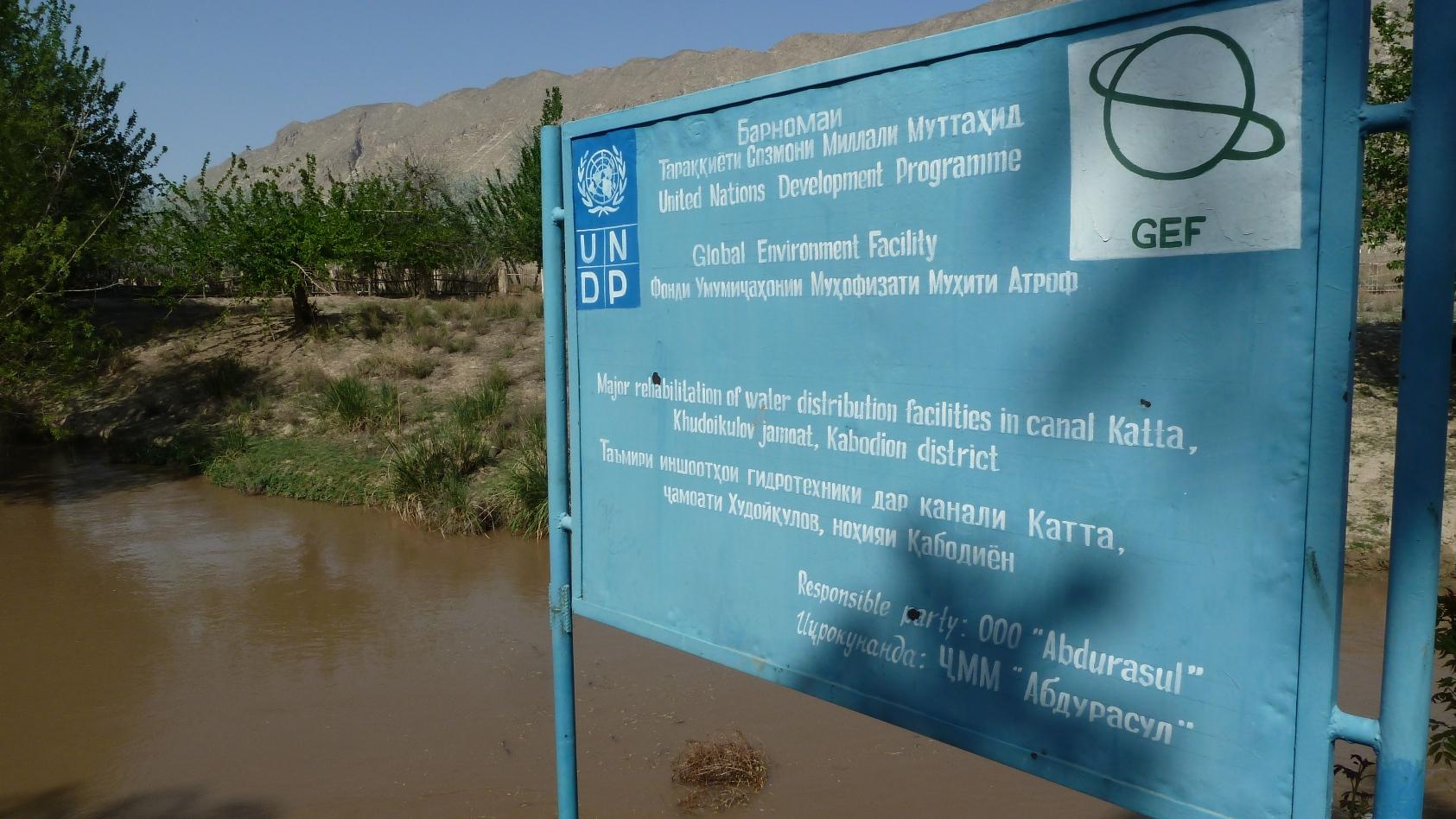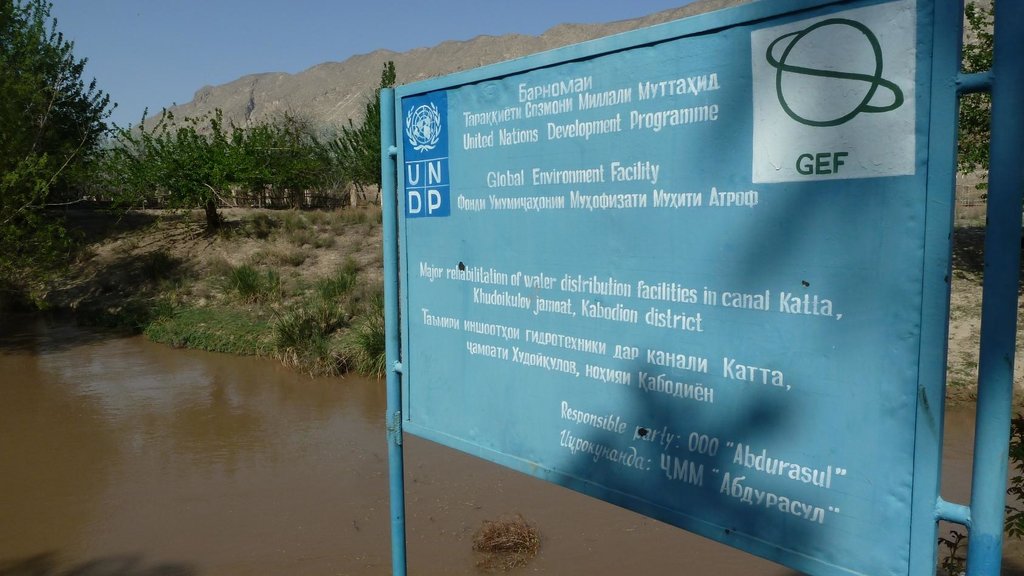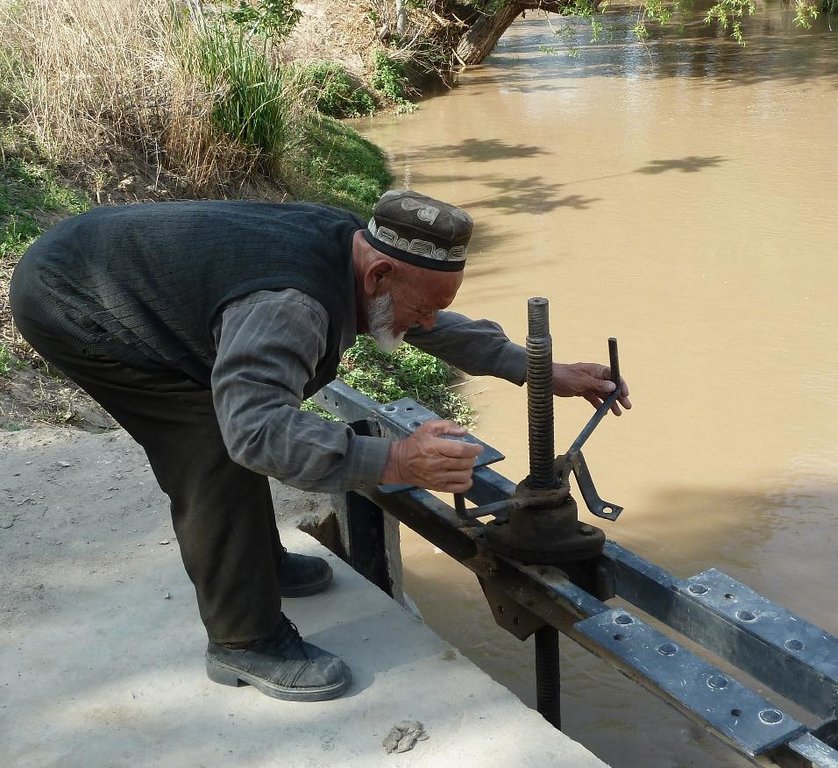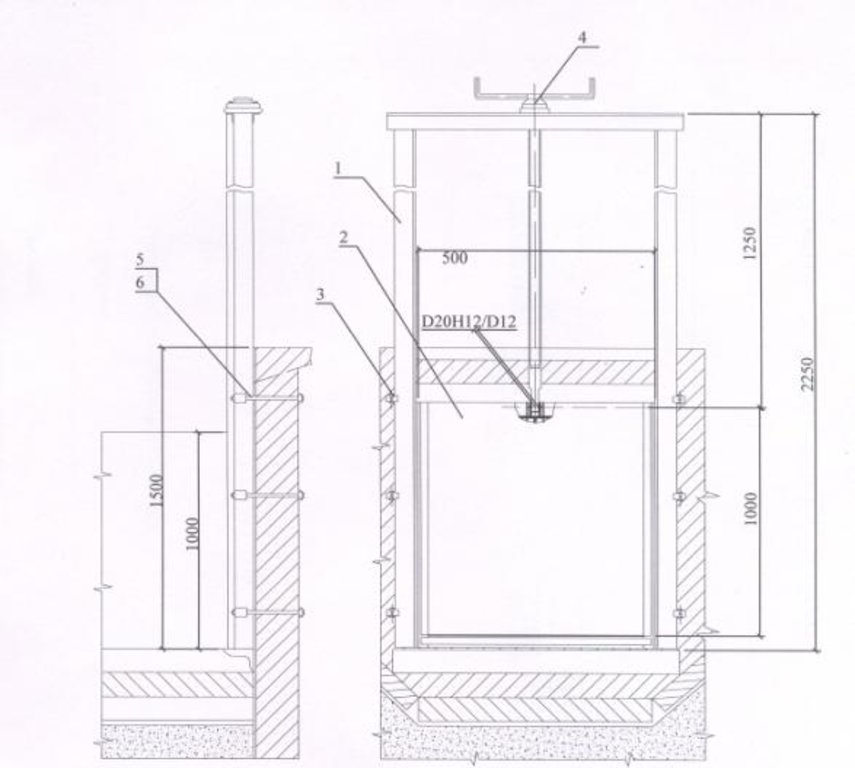Rehabilitation of iron water gates to improve distribution of irrigation water [塔吉克斯坦]
- 创建:
- 更新:
- 编制者: Natalia Mityakova
- 编辑者: –
- 审查者: David Streiff
technologies_1444 - 塔吉克斯坦
- Rehabilitation of iron water gates to improve distribution of irrigation water: March 15, 2017 (inactive)
- Rehabilitation of iron water gates to improve distribution of irrigation water: July 20, 2017 (inactive)
- Rehabilitation of iron water gates to improve distribution of irrigation water: Aug. 20, 2019 (inactive)
- Rehabilitation of iron water gates to improve distribution of irrigation water: Nov. 2, 2021 (public)
查看章节
全部展开 全部收起1. 一般信息
1.2 参与该技术评估和文件编制的资源人员和机构的联系方式
SLM专业人员:
SLM专业人员:
有助于对技术进行记录/评估的机构名称(如相关)
CDE Centre for Development and Environment (CDE Centre for Development and Environment) - 瑞士有助于对技术进行记录/评估的机构名称(如相关)
United Nations Development Program (United Nations Development Program) - 塔吉克斯坦有助于对技术进行记录/评估的机构名称(如相关)
Central Asian Countries Initiative for Sustainable Land Management - Multicountry Capacity Building (CACILM - MCB) - 吉尔吉斯斯坦1.3 关于使用通过WOCAT记录的数据的条件
(现场)数据是什么时候汇编的?:
13/04/2011
编制者和关键资源人员接受有关使用通过WOCAT记录数据的条件。:
是
2. SLM技术的说明
2.1 技术简介
技术定义:
The recycling of broken iron water gates which can be used to regulate the water flow into smaller side canals were reconstructed along the main irrigation canal.
2.2 技术的详细说明
说明:
This technology is based on the rehabilitation of iron water gates which regulate the water flow into smaller side canals along the main irrigation canal.
Purpose of the Technology: After the collapse of the Soviet Union irrigation facilities in the Shaartuz area were neglected and consequently broke down. In this arid environment, (only about 100 mm annual precipitation) many fields were subsequently abandoned due to a lack of irrigation water. Conflicts arose between people living upstream and downstream along the main irrigation canals as water flow could not be regulated anymore. During the wet spring period the side canals connecting the main canal with the fields had to be monitored day and night, and could only be plugged with vegetative material to protect the fields from flooding. Upstream users received all the water available, and at the same time suffered from waterlogging and water erosion. Downstream users however suffered from a lack of irrigation water, which led to severe conflicts between the different land users.
Establishment / maintenance activities and inputs: In order to help solve these problems, during 2010 UNDP replaced the 32 damaged irrigation gates along the irrigation canal. 12 big and 20 small iron gates were set up to regulate the water flow. Water distribution was regulated according to norms defining water need per ha of irrigated field and taking into account crop and soil types. Farmers then paid for the irrigation water according to those norms. The financial contributions go the Water Agency and are used for canal maintenance. Ideally the channels require cleaning every year as they get filled up with sand and other dirt washed in by the water. Irrigation gates if used appropriately should not need repair for at least the first five years after installation. After that some minor repairs are required which can take up to 4-5 days for the concrete works to be finished and to dry.
Natural / human environment: As a result of the replacement of these water distribution facilities, the irrigation and ameliorative condition of 3,570 ha of land were improved, including around 1,000 ha of kitchen gardens. Around 32,000 people are now benefiting from this intervention. Livelihoods have greatly improved as farmers now feel encouraged to invest in agricultural activities. According to local farmers, now only 1 out of 4 people have to migrate to Russia whereas before the implementation of this sub-project most of them would have been forced to leave the country. As the neglect of irrigation systems from the Soviet times is a problem all over the irrigated lowlands of Tajikistan, this technology could prove highly useful for a more widespread application.
2.3 技术照片
2.5 已应用该技术的、本评估所涵盖的国家/地区/地点
国家:
塔吉克斯坦
区域/州/省:
Khatlon
有关地点的进一步说明:
Kabodion / Khudoikulov
Map
×2.6 实施日期
如果不知道确切的年份,请说明大概的日期:
- 不到10年前(最近)
2.7 技术介绍
详细说明该技术是如何引入的:
- 通过项目/外部干预
注释(项目类型等):
2010
3. SLM技术的分类
3.1 该技术的主要目的
- access to water
3.2 应用该技术的当前土地利用类型

农田
- 一年一作
主要农作物(经济作物及粮食作物):
major cash crop: tomatoes, beans, corn, wheat, watermelon, onion
注释:
Major land use problems (compiler’s opinion): degradation of vegetation cover, loss of topsoil through wind erosion, access to water is restricted.
Major land use problems (land users’ perception): waterlogging, reduced rational use of water and land resources, flooding, water use conflicts, lack of irrigation water, water erosion
3.3 有关土地利用的更多信息
该技术所应用土地的供水:
- 充分灌溉
每年的生长季节数:
- 1
具体说明:
Longest growing period in days: 240Longest growing period from month to month: March-October
3.4 该技术所属的SLM组
- 灌溉管理(包括供水、排水)
3.5 技术传播
具体说明该技术的分布:
- 均匀地分布在一个区域
如果该技术均匀地分布在一个区域上,请注明覆盖的大致区域。:
- 10-100 平方千米
注释:
around 3'600 ha of land profit from the rehabilitation of water gates
3.6 包含该技术的可持续土地管理措施

结构措施
- S3:分级沟渠、渠道、水道
注释:
Main measures: structural measures
3.7 该技术强调的主要土地退化类型

土壤水蚀
- Wg:冲沟侵蚀/沟蚀

物理性土壤退化
- Pw:水浸

水质恶化
- Hs:地表水良变化
注释:
Main type of degradation addressed: Pw: waterlogging, Hs: change in quantity of surface water
Secondary types of degradation addressed: Wg: gully erosion / gullying
Main causes of degradation: over abstraction / excessive withdrawal of water (for irrigation, industry, etc.) (upstream users took all the irrigation water available), inputs and infrastructure: (roads, markets, distribution of water points, other, …) (due to the rundown irrigation facilities, waterflow could not be properly regulated anymore), governance / institutional (after the collapse of the Soviet Union, nobody ensured proper maintenance of the irrigation facilities)
3.8 防止、减少或恢复土地退化
具体数量名该技术与土地退化有关的目标:
- 减少土地退化
- 修复/恢复严重退化的土地
注释:
Secondary goals: prevention of land degradation
4. 技术规范、实施活动、投入和成本
4.1 该技术的技术图纸
4.2 技术规范/技术图纸说明
Specifications:
1. Hoist-Head Frame PS-50-100 01.000 – 1 unit
1. Embedded Frame PS-50-100 03.000 – 1 unit
2. Gate PS 50-100 02.000 – 1 unit
3. Backing block PS 50-100 00.001
4. Screw hoist 1 EV TP №820-165 Model B-73 – 1 unit
5. Screw M20x300.4.6.02 State Standard 7798-70 – 6 units
6. Screw nut M20.8.02 State Standard 5915-70 – 6 units
Technical characteristics:
1. Total mass - 90kg
2. Pressure – 1.25m
3. Full hydrostatic pressure – 0.8 ton
4. Rated force – 0.6 ton
Location: Shaartuz. Khatlon
Technical knowledge required for field staff / advisors: high (installation of the water gates)
Technical knowledge required for land users: low
Main technical functions: control of concentrated runoff: drain / divert, water harvesting / increase water supply, water spreading
Waterway
Height of bunds/banks/others (m): 2.25
Width of bunds/banks/others (m): 0.5
Construction material (concrete): concrete
Construction material (other): metal
4.3 有关投入和成本计算的一般信息
具体说明成本计算所用货币:
- 美元
4.4 技术建立活动
| 活动 | 措施类型 | 时间 | |
|---|---|---|---|
| 1. | Installation of irrigation gates along main irrigation channel | 结构性的 |
4.5 技术建立所需要的费用和投入
| 对投入进行具体说明 | 单位 | 数量 | 单位成本 | 每项投入的总成本 | 土地使用者承担的成本% | |
|---|---|---|---|---|---|---|
| 劳动力 | Installation of irrigation gates | Persons/day | 25.0 | 4.44 | 111.0 | |
| 施工材料 | Watergate | gates | 1.0 | 300.0 | 300.0 | |
| 技术建立所需总成本 | 411.0 | |||||
如果土地使用者负担的费用少于100%,请注明由谁负担其余费用:
UNDP
4.6 维护/经常性活动
| 活动 | 措施类型 | 时间/频率 | |
|---|---|---|---|
| 1. | Cleaning of irrigation channels | 结构性的 | annual |
| 2. | Irrigation gates might need some minor repair after 5 years | 结构性的 | irregular |
4.7 维护/经常性活动所需要的费用和投入(每年)
| 对投入进行具体说明 | 单位 | 数量 | 单位成本 | 每项投入的总成本 | 土地使用者承担的成本% | |
|---|---|---|---|---|---|---|
| 劳动力 | Cleaning of irrigation channels | Persons/day | ||||
| 劳动力 | Repairing irrigation gate | Persons/day | 5.0 | 4.4 | 22.0 | |
| 技术维护所需总成本 | 22.0 | |||||
注释:
The costs are indicated for the installation of one big water gate.
4.8 影响成本的最重要因素
描述影响成本的最决定性因素:
The most determinate costs are those for the purchase of water gates. Cleaning of channels was not part of this project, and therefore only installation of water distribution facilities have been completed. Channels are usually cleaned by local users who are in many cases supported by international donors.
5. 自然和人文环境
5.1 气候
年降雨量
- < 250毫米
- 251-500毫米
- 501-750毫米
- 751-1,000毫米
- 1,001-1,500毫米
- 1,501-2,000毫米
- 2,001-3,000毫米
- 3,001-4,000毫米
- > 4,000毫米
农业气候带
- 干旱
Thermal climate class: temperate
5.2 地形
平均坡度:
- 水平(0-2%)
- 缓降(3-5%)
- 平缓(6-10%)
- 滚坡(11-15%)
- 崎岖(16-30%)
- 陡峭(31-60%)
- 非常陡峭(>60%)
地形:
- 高原/平原
- 山脊
- 山坡
- 山地斜坡
- 麓坡
- 谷底
垂直分布带:
- 0-100 m a.s.l.
- 101-500 m a.s.l.
- 501-1,000 m a.s.l.
- 1,001-1,500 m a.s.l.
- 1,501-2,000 m a.s.l.
- 2,001-2,500 m a.s.l.
- 2,501-3,000 m a.s.l.
- 3,001-4,000 m a.s.l.
- > 4,000 m a.s.l.
5.3 土壤
平均土层深度:
- 非常浅(0-20厘米)
- 浅(21-50厘米)
- 中等深度(51-80厘米)
- 深(81-120厘米)
- 非常深(> 120厘米)
土壤质地(表土):
- 粗粒/轻(砂质)
表土有机质:
- 低(<1%)
如有可能,附上完整的土壤描述或具体说明可用的信息,例如土壤类型、土壤酸碱度、阳离子交换能力、氮、盐度等。:
Soil fertility is very low
Soil drainage / infiltration is poor
Soil water storage capacity is low
5.4 水资源可用性和质量
地表水的可用性:
过量
水质(未处理):
仅供农业使用(灌溉)
关于水质和水量的注释和进一步规范:
Availability of surface water: Excess in case of heavy rainfall events but at rest of the year the availabilty is poor/none.
5.5 生物多样性
物种多样性:
- 低
5.6 应用该技术的土地使用者的特征
生产系统的市场定位:
- 混合(生计/商业
个人或集体:
- 团体/社区
机械化水平:
- 畜力牵引
- 机械化/电动
说明土地使用者的其他有关特征:
Land users applying the Technology are mainly common / average land users
Population density: 50-100 persons/km2
Annual population growth: 2% - 3%
Level of mechanization: Also manual labour.
5.7 应用该技术的土地使用者拥有或租用的平均土地面积
- < 0.5 公顷
- 0.5-1 公顷
- 1-2 公顷
- 2-5公顷
- 5-15公顷
- 15-50公顷
- 50-100公顷
- 100-500公顷
- 500-1,000公顷
- 1,000-10,000公顷
- > 10,000公顷
这被认为是小规模、中规模还是大规模的(参照当地实际情况)?:
- 中等规模的
注释:
Average area of land owned or leased by land users applying the Technology: Also 15-50 ha but less common
5.8 土地所有权、土地使用权和水使用权
土地所有权:
- 州
土地使用权:
- 社区(有组织)
- water is paid
用水权:
- 社区(有组织)
- water is paid
5.9 进入服务和基础设施的通道
健康:
- 贫瘠
- 适度的
- 好
教育:
- 贫瘠
- 适度的
- 好
技术援助:
- 贫瘠
- 适度的
- 好
就业(例如非农):
- 贫瘠
- 适度的
- 好
市场:
- 贫瘠
- 适度的
- 好
能源:
- 贫瘠
- 适度的
- 好
道路和交通:
- 贫瘠
- 适度的
- 好
饮用水和卫生设施:
- 贫瘠
- 适度的
- 好
金融服务:
- 贫瘠
- 适度的
- 好
6. 影响和结论性说明
6.1 该技术的现场影响
社会经济效应
生产
作物生产
注释/具体说明:
indirect benefit
生产区域
注释/具体说明:
Previously the rehabilitation of water distribution facilities land was abandoned
水资源可用性和质量
家畜用水的可用性
注释/具体说明:
water for household needs
灌溉用水的可用性
收入和成本
工作量
注释/具体说明:
Previously the gates had to be monitored all the time
社会文化影响
食品安全/自给自足
冲突缓解
注释/具体说明:
reduced conflicts about water availability
Livelihood and human well-being
注释/具体说明:
Farmers feel more confident about investing in other agricultural activities as they can rely on having access to irrigation water which prevents them from needing to migrate for work.
生态影响
水循环/径流
水量
水的回收/收集
地表径流
多余水的排放
减少气候和灾害风险
干旱影响
6.2 该技术的场外影响已经显现
水资源可用性
6.3 技术对渐变气候以及与气候相关的极端情况/灾害的暴露和敏感性(土地使用者认为的极端情况/灾害)
渐变气候
渐变气候
| 季节 | 气候变化/极端天气的类型 | 该技术是如何应对的? | |
|---|---|---|---|
| 年温度 | 增加 | 好 |
气候有关的极端情况(灾害)
气象灾害
| 该技术是如何应对的? | |
|---|---|
| 局地暴雨 | 不好 |
| 局地风暴 | 好 |
气候灾害
| 该技术是如何应对的? | |
|---|---|
| 干旱 | 好 |
水文灾害
| 该技术是如何应对的? | |
|---|---|
| 比较和缓的(河道)洪水 | 不好 |
其他气候相关的后果
其他气候相关的后果
| 该技术是如何应对的? | |
|---|---|
| 缩短生长期 | 好 |
注释:
Flood diversion channels were built and so in case of floods there is an emergency system in place.
6.4 成本效益分析
技术收益与技术建立成本相比如何(从土地使用者的角度看)?
短期回报:
中性/平衡
长期回报:
非常积极
技术收益与技术维护成本/经常性成本相比如何(从土地使用者的角度看)?
短期回报:
积极
长期回报:
积极
6.5 技术采用
- 大于 50%
在所有采用这项技术的人当中,有多少人是自发地采用该技术,即未获得任何物质奖励/付款?:
- 0-10%
注释:
100% of land user families have adopted the Technology with external material support
Comments on spontaneous adoption: UNDP paid for installation of water gates
There is a moderate trend towards spontaneous adoption of the Technology
Comments on adoption trend: however the only issue with installation of water gates is that they require a sufficient amount of funding (mostly external).
6.7 该技术的优点/长处/机会
| 土地使用者眼中的长处/优势/机会 |
|---|
| Reduced conflicts about water distribution as previously upstream users received all the available water and downstream users received nothing |
| Reduced workload as previously gates had to be constantly monitored |
| Improved livelihoods due to regular water access |
| Increased confidence of farmers to invest in other agricultural activities due to more guaranteed water availability |
| Less migration to Russia as income opportunities through agriculture have improved |
| 编制者或其他关键资源人员认为的长处/优势/机会 |
|---|
|
Improved regulation of water flow as previously some areas suffered from flooding and waterlogging whereas others did not receive enough water. How can they be sustained / enhanced? Ensure proper maintenance of the facilities |
6.8 技术的弱点/缺点/风险及其克服方法
| 编制者或其他关键资源人员认为的弱点/缺点/风险 | 如何克服它们? |
|---|---|
| High costs involved with the installation of such an irrigation system along a whole canal | If every collective farm along the river pays for the gates within their territory, the costs could be divided between them. |
链接和模块
全部展开 全部收起链接
无链接
模块
无模块






